Which Of The Following Is Not A Commonly Used Bi Tool?
There is golden knowledge in the sea of data that businesses are swimming in. Being able to fish out the business intelligence y'all need — when you lot need information technology — is the key to steering your ship.
In this article, we'll talk over 10 BI tools that feature data visualization and analysis.
Some of these tools started life as enterprise reporting tools and expanded to self-service BI. Others started out as self-service information visualization tools and may or may not have added advanced reporting. Some tools tin read large datasets in place, from a data lake or Hadoop; others must import all information. Deployments may be cloud-only or allow on-premises installation.
Birst
 Martin Heller/IDG
Martin Heller/IDG Birst bills itself every bit Enterprise BI with blazing fast data discovery. The Birst compages connects the entire organization through a network of interwoven virtualized BI instances on elevation of a shared common analytical fabric.
Birst has a multi-tenant architecture. It tin can be deployed in the public cloud, in AWS, or on-bounds as a virtual appliance.
According to Gartner, three quarters of Birst'due south reference customers said information technology was their only enterprise standard for analytics and BI, and that 98 pct of Birst reference customers await to continue using the product. Both are impressive expressions of support from users. On the other mitt, Gartner reports that a large portion of Birst'southward reference customers are using the product primarily for parameterized dashboards and reports, with only small portions using the product for more than sophisticated analytic tasks. The production does support circuitous data models.
Domo
 Martin Heller/IDG
Martin Heller/IDG Domo combines a large assortment of data connectors, an ETL system, a unified data store, a selection of visualizations, integrated social media, and reporting into ane online BI tool. It is aimed directly at senior executives and line-of-business users who need an intuitive business-facing dashboard. Domo claims to be more than a BI tool because its social media tool tin can lead to "actionable insights." But, in practice, every BI tool either leads to actions that do good the business concern or it ends up getting tossed onto the rubbish heap so that is hype is to be taken with a grain of common salt.
Domo is, however, a very good and capable BI organisation. It stands out from the others by offer back up for lots of information sources andlots of nautical chart types. The integrated social media feature isnice despite the hype. However, Domo is harder to learn and use than Tableau, Qlik Sense, and Ability BI, and at $2,000 per user per year it is many times more than expensive than other tools.
Microsoft Ability BI
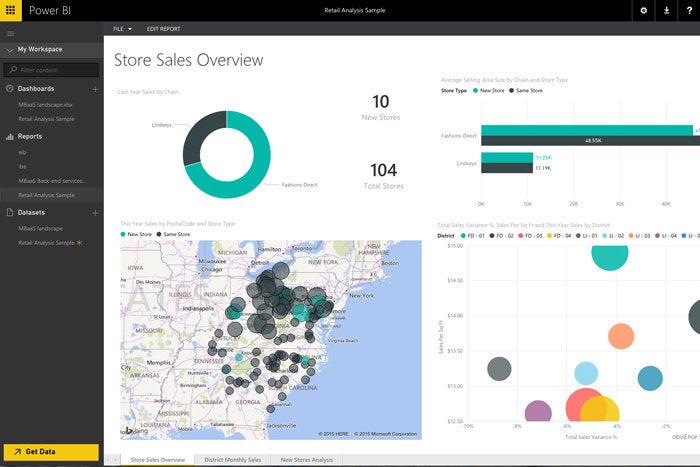 Martin Heller/IDG
Martin Heller/IDG Microsoft Power BI is a suite of business analytics tools that run more often than not on Azure and that connect to hundreds of data sources, simplify information prep, and bulldoze ad-hoc assay. It is also 1 of the lowest-cost BI solutions on the market, with a price of $nine.99 per user, per month for Power BI Pro, a complimentary Windows desktop analysis tool, and costless mobile viewer apps. Ability BI Premium, a virtual server priced from $4,995 per month depending on chapters, does not crave named user licenses, and includes Power BI Report Server, which can exist run on-premise.
Power BI scores high on easeof use, but according to Gartner the scores from its reference clients place information technology in the bottom quartile for breadthof use. Most of Microsoft's reference customers (59%) mainly use Power BI'due south parameterized reports and dashboards, rather than using information technology for more than circuitous tasks. The average proportion of business users authoring their own content with Microsoft Power BI is 20 percent, which is very low.
MicroStrategy
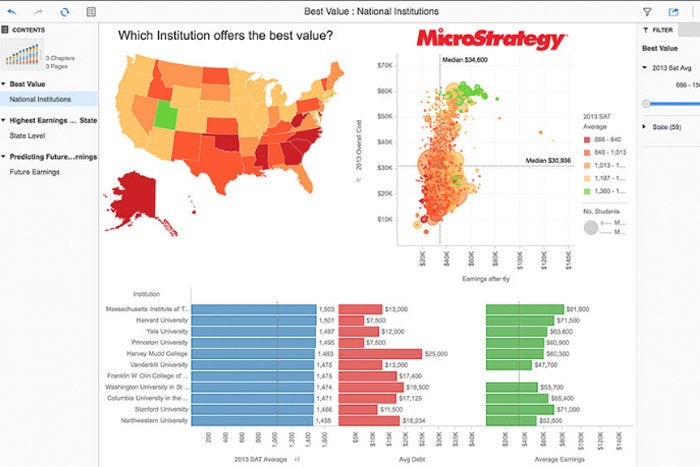 Martin Heller/IDG
Martin Heller/IDG MicroStrategy combines cocky-service visual data discovery and analytics with enterprise analytics and reporting that is suitable for large-scale systems of record. It offers a single integrated platform with many different license options for data consumer and ability-user roles. Clients are available for web, desktop, and mobile. Servers are available for reporting, intelligence, in-memory analytics, transactions, distribution, collaboration, geospatial services, badges, and telemetry. Drivers are available for relational databases, OLAP, and Hadoop.
MicroStrategy has made a long slog from its historical focus on enterprise reporting to now also being able to satisfy self-service users and to enable easy departmental deployments on AWS. Outside of its customer base, however, information technology remains virtually unknown.
Qlik Sense
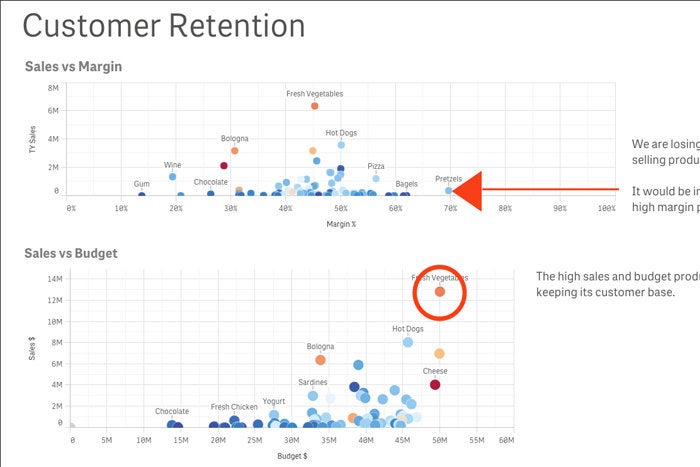 Martin Heller/IDG
Martin Heller/IDG Qlik Sense offers governed data discovery, agile analytics, and BI. And information technology uses a scalable associative in-retentivity engine that tin also be used every bit a data mart. It can also provide enterprise reporting using its optional Qlik NPrinting server module.
When working with Qlik Sense, you tin can relieve a bookmark to the current option in the current canvass. Then you can combine bookmarks into stories and add text and other annotations to make the story cocky-explanatory. If you're using a story for a alive presentation, you tin can drill down to the source for any visualization to answer — and illustrate — questions that come up upwards. Once you take answered the question, you can easily return to the story.
Qlik's associative dark-green-white-grey experience in which colors of displayed values indicate state (selected-selectable-not selectable) helps you to spot both related and unrelated data without having to dig — a very overnice touch. Qlik claims that its associative engine can discover insights that query-based BI tools miss. The Qlik DataMarket gives you access to curated external data that you can use to augment and cross reference your internal data.
Salesforce Einstein Analytics
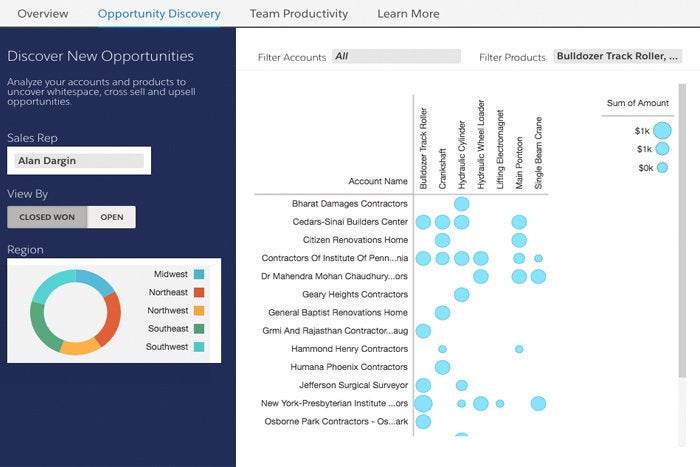 Martin Heller/IDG
Martin Heller/IDG Salesforce Einstein Analytics gives you a clear view into your Salesforce data, helping to highlight critical performance metrics and trends. The Einstein Analytics Platform lets you build custom point-and-click interactive visualizations, dashboards, and analysis with integrated self-service data preparation using Salesforce and (for more than money) not-Salesforce information. In addition, Salesforce Einstein offers specialized apps for sales, service, B2B marketing, and AI-assisted discovery.
SAS Visual Analytics
 Martin Heller/IDG
Martin Heller/IDG SAS, a visitor ameliorate known for its data scientific discipline and statistical assay products, offers SAS Visual Analytics, which provides interactive reporting, visual discovery, self-service analytics, scalability, and governance, using an in-retentiveness environment. It includes predictive analytics to assess possible outcomes and make data-driven decisions, which SAS claims is easy enough for a concern analyst.
SAS Visual Analytics tin exist deployed on-bounds, in SAS information centers, or in the public deject. It is strong on interactive visual exploration and analytic dashboards. It supports advanced nautical chart types too every bit avant-garde analytics, and allows for R, Python, Coffee, and Lua models as well as SAS models.
Sisense
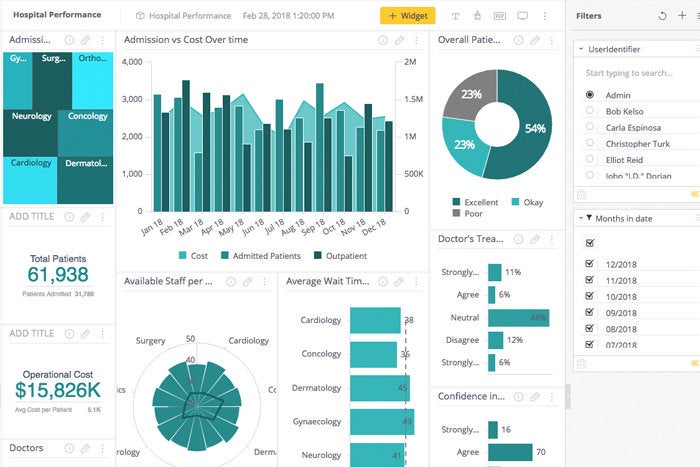 Martin Heller/IDG
Martin Heller/IDG Sisense is an integrated, terminate-to-end, analytics and BI platform, built on an in-memory columnar database, offering visual data exploration, dashboards, and embedded advanced analytics features. Sisense can be deployed on-bounds; in public, private, or hybrid cloud; and as a managed service.
One differentiator claimed by Sisense is that it makes heavy use of on-CPU retentivity (cache) to move data l-100 times faster than in RAM. While Sisense emphasizes its scalability, its average deployment size is 300 users, according to Gartner.
Tableau
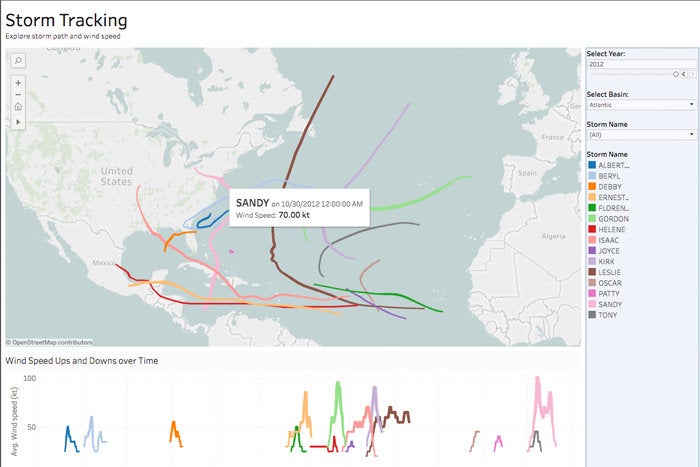 Martin Heller/IDG
Martin Heller/IDG Tableau is an analytics platform as a service with stiff visual data discovery. The base platforms are Tableau Server (Windows or Linux) and Tableau Online (hosted). Users can be Creators, Explorers, or Viewers. Creators have licenses to the Server or Online versions, as well equally to Tableau Prep (data preparation) and Tableau Desktop (Windows and macOS).
Tableau besides offers two complimentary desktop apps for Windows and macOS: Tableau Public and Tableau Reader. Tableau Public tin can both open and create analyses that reside on your Tableau Public profile. Tableau Reader can open and collaborate with data visualization files built in Tableau Desktop.
ThoughtSpot
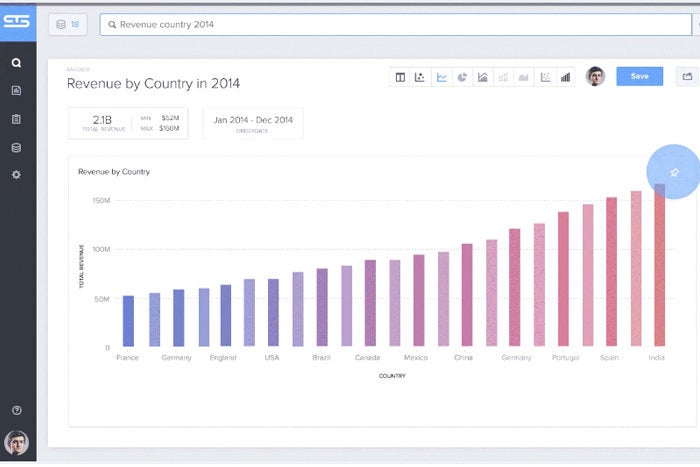 Martin Heller/IDG
Martin Heller/IDG Thoughtspot features a search-based approach to visual analytics and the power to integrate, ready and search billions of rows and terabytes of information. Thoughtspot claims it can respond in seconds to searches of billions of rows. Information technology accomplishes this with an in-memory, massively parallel processing (MPP) columnar database and a distributed cluster manager.
Thoughtspot besides sports SpotIQ, an "AI-driven" analytics, that users tin can run on the query result data to uncover anomalies, trend lines, clusters, and other data features using statistical and machine learning algorithms. SpotIQ generates natural-language narratives for any insights it uncovers. If this sounds like the Google-ization of BI, that's non an accident: several of the founders are Google alumni.
Which Of The Following Is Not A Commonly Used Bi Tool?,
Source: https://www.cio.com/article/220583/top-10-bi-data-visualization-tools.html
Posted by: cartwrightpospot.blogspot.com


0 Response to "Which Of The Following Is Not A Commonly Used Bi Tool?"
Post a Comment